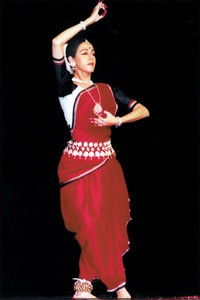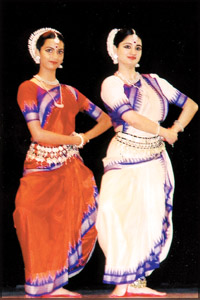An inspiring recital of Odissi dance
Tennyson Rodrigo
|

POISE: Srimathi Bindu Juneja in a dance pose.
|
|

DUO: Gitanjali Singh Deo and Kalyani Phagre
|
DANCE: There couldn't have been a more fitting event to celebrate the
sixtieth anniversary of India's independence than the delightful
performance of 'Odissi' dance held at the Bishop's College Auditorium on
August 15.
Srimathi Bindu Juneja along with her two disciples (Gitanjali Singh
Deo and Kalyani Phagre) and a quartet of musicians gave a dedicated
performance that defined the quintessence of India's Odissi dance form.
It was a rare gift to have had the opportunity to be a part of the
audience and imbibe the beauty of it all.
A haunting after-taste of this aesthetic experience coerced me to
reflect on an explore the underlying mystique of India's classical dance
heritage. In this endeavour, I might have inescapably been drawn into
anexcessive interpretation of the evening's impressions. If in that
process my imagination has stretched beyond the boundaries of Bindu
Juneja's idea and creativity, so be it.
India's great dance heritage
Although Bindu Juneja first trained as a Bharatha Natyam dancer, she
was soon attracted to the Odissi form of dance in which she is a skilled
exponent.
It's awesome even to contemplate on how one could capture in a few
paragraphs, the origins, evolution and the surviving foundations of
India's contemporary classical dance forms. Stated simply and broadly,
they are the contemporary expressions in that genre of the culture and
ethos of a particular region or a group of people.
There are about six recognized classical dance forms each of which
represents a distinguishing set of ethnic, cultural and artistic
identities: Kathakali and Mohiniyattam of Kerala, Kathak of Uttar
Pradesh, Manipuri of Manipur, Bharata Natyam of Tamilnadu and Odissi of
Orissa are the main forms.
|

HARMONY: The orchestra |
While these dance forms are well differentiated, two profound and
ancient inheritances have bestowed upon all of them a heritage of
commonality. The first is that they all owe the basics of their
aesthetics to the seminal treatise known as "Natya Shastra", written by
the sage Bharatha Muni during 200 BC-200 AD.
Natya Shastra is the world's oldest surviving treatise on all aspects
of dance, dramaturgy, music, theatre. instruments and all else
associated with stagecraft and aesthetics.
The second is the availability of a rich and infinite repository of
substance that provides the essential inspiration for creativity and the
content for narrative and choreographic expression. This repository is
the bedrock of India's timeless spiritual heritage-manifested typically
in its mythology, mysticism, philosophy, literature, poetry and systems
of belief.
Some believe that as between the different dance forms, Bharatha
Natyam and Odissi are the more faithful adherents of the canonic
prescriptions of the Natya Shastra. Whilst that might be arguable and of
limited relevance, a comparison of some features of the two forms would
illustrate how India's classical dance forms with a common heritage
assert their identities to this day.
Bharatha Natyam has a titanic majesty and is steeped in tradition and
technical complexity, its symmetrical and angled movements are vigorous
and sculpturally granitic.
A recital of Bharatha Natyam is formally structured much like a
monumental symphony of several movements in baroque/classical style.
Odissi on the other hand is graceful, sensuous and fluid.
It "Thribangi" posture of tilting the neck, waste and the knee to
create a helix-like shape in space is characteristic. It veers towards
'romanticism' and can be rendered as stand-alone dance episodes either
in solo form or as ensembles.
Music is integral and inseparable to both dance forms and yet the
differentiation is tangibly evident. For example, on Odissi the pakhavaj
replaces the mridangam of Bharatha Natyam; the sitar replaces the violin
and North Indian ragadhari music replaces the carnatic tradition.
Buddhopadesh
The customary beginning of an Odissi recital is the Mangalacharan -
an invocation to a presiding deity such as Lord Jaganath to seek his
blessings. On this occasion however, Bindu Juneja had attached the
epithet "Buddhopadesh" to her Mangalacharan.
The printed program also noted within parenthesis that the opening
item was "specially (sic) composed for the occasion."
The state of Orissa in eastern India (part of the ancient Kalinga
empire) is the abode of today's Odissi dance. It also has a special
place in Buddhist history as it evokes the supreme act of Emperor
Asoka's embrace of Buddhism after his relentless and brutal pursuit of
warfare that cost countless human lives.
Fast-forwarding to contemporary times, an Odissi dancer was to
perform in a country where a Buddhist consciousness is vibrantly alive.
And so here was a contextual platform for Bindu Juneja, who is also a
graduate in Arts, to adorn her Mangalacharan with some legendary
Buddhist wisdom.
The item started with a melodic refrain without rhythm on the bansuri
(flute), impressionistically suggestive of Yaman or Kalyani ragas; the
ambience was sublime and calming. As the deep resonating beat of the
Pakhavaj introduced the rhythm, Bindu Juneja appeared on the stage like
an inspired angel eager to narrate a story of devotion.
The lithe footwork and her sculpturesque postures were exquisite and
graceful; she was the epitome of a compact Odissi exponent. The story
was told in the "Nritya" idiom of representational classical dance -
with the gestures, moods, emotions and all else it entails. It was also
a perfect exposition of the inseparability of music, song and dance.
The lyrics were in Sanskrit and possibly nobody in the audience
understood the deeper meaning of the dancer's story. But the word
Buddhopadesh was clearly meant to be the guiding words of the Buddha.
If one didn't understand the lyrics, the amalgam of dance and music
alone was transcendental. There was devotion written on each and every
step, bodily movement and facial expression. As the item ended with a
sublime "Mudra of Salutation", eyes closing and lights fading, the
ultimate extinction and the ephemerality of all things was serenely
symbolized.
While the visual and aural impacts were elevating, for me there was
still a void - a compelling curiosity as to what the Sanskrit lyrics
conveyed. After the recital was over, I rushed to accost the musicians
to inquire how I might get to know the story of the dance.
Spontaneously and willingly I was given a few photo-copied pages that
contained in Devanagari script what I believed was at least part of the
story that the vocalist sang.
The next day I consulted my dear friend and erudite scholar, Ratna
Handurukande, Emeritus Professor of Sanksrit, University of Peradeniya,
who happily and willingly satiated my curiosity.
In a neat written interpretation of her own she conveyed to me that
the story was an ornate poem titled 'Saundaranandam Kavyam' by poet
Asvagohosha who lived in the first century AD. Saundaranandam is derived
from an amalgamation of Sundari and Nanda. Nanda (who was Buddha's first
cousin) and Sundari were in love with each other.
I would sidetrack further away from the Odissi recital if I were to
deal with the Ashvaghosa's poem chapter and verse. But I cannot resist
reproducing just two lines from the stanza dealing with Nanda's enforced
renunciation.
"Of joys (ananda) the joy of spirituality is the greatest.
Of sorrows, the sorrow of ignorance is the most sorrowful."
The Pallavis
There were two separate items in the program titled 'Pallavi'. The
first in raga Jaitkalyan was performed by Bindu Juneja while the other
was a duet by Gitanjali Deo and Kalyani Phagre in raga Shankarabharanam.
In a very brief introduction, an announcer referred to 'Pallavi' as a
tender blossom'. In the course of my searches, I found that in Sanskrit
the word 'Pallava' could mean 'leaf'. There is also an explanation that
it means an 'elaboration' giving an inkling of an 'awaiting to blossom
out'. And in carnatic music it has an entirely different meaning that's
totally unrelated to dance.
Semantics apart, Pallavi in Odissi is pure dance 'Nritta', devoid of
narrative content. Perhaps the tightest fusion between music and dance
is the defining quality of Pallavi, with rhythmic intricacies in full
flow. Furthermore, it is pronouncedly, 'music-oriented' with the
exposition of a specific raga and the cascading of rhythmic patterns;
the extensive use of Jatis (vocally rendered rhythmic syllables) and
Swaras (sung notes), is analogous to the Tillana in Bharatha Natyam.
Starting with a sense of immediacy, the dancer accelerates to
demonstrate the lyrical charm, grace, artistry and mastery of the
dancer. The virtuosic synchronisation between the rhythms of the Jatis,
postural flow in space and the floor-stamping feet - adorned with ankle
bells - was riveting. It was a treat to see all that mastery and
artistry in the Pallavi of Bindu Juneja.
The Pallavi duet was the first appearance of her two disciples. Their
entry on to the stage was indeed like adjacent tender blossoms; as they
danced briskly, the white semi-circular headgear moved in tandem like
two floating halos. During the entire dance the duo rarely separated
more than a metre from each other as they moved deftly and in synchrony
with mesmerising drumbeats and the frenzied vocal renderings.
Ramashtakam and the Tandava
Ramashtakam is an octet of versus extolling the attributes of
Ramachandara (Rama); the versus were sung by the vocalist with musical
accompaniment and the dance was performed by Bindu Juneja; the Shiva
Tandava Stotra was a hymn of praise attributed to Ravana who was a
passionate devotee of Lord Shiva.
Here again the dancer plunged into the rich reservoir of Hindu
mythology to weave the attributes of her chosen characters in a
representational Odissi exposition.
The oneness of souls
The dance recital was a joint presentation by the Indian Council of
Cultural Relations and the High Commission of India. There was a sheet
of paper placed on every seat in the auditorium seeking answers to a
questionnaire on the performance.
I was somewhat clueless about filling a questionnaire on an aesthetic
experience of this nature. And I refrained. But it would be interesting
to know the interpretation of what the audience had to say and the
conclusions reached.
We don't hear much about the Indian Council of Cultural Relations. It
would be wonderful if programs of Indian classical music and dance are
more frequently staged in Sri Lanka under the auspices of this
institution. The creative imagination inherent in India's classical
heritage is infinite and edifying.
A former Indian High Commissioner had once referred to India and Sri
Lanka as "Two Nations with One Soul". India is modernising rapidly and
there is an associated gung-ho consciousness associated with it.
Bollywood and the swinging, urban jet set of the fast-growing affluent
are defining a new India. And Sri Lanka, tragically, is drowning in a
culture of violence, conflict and bitter political acrimony.
The concept of two merged souls or the spiritual sanctity of a
traditional single soul could be anachronistic. Yet, for India's
classical art forms there is still hope. It's ages since the dancing
devadasis of ancient times were stamped out; yet, since then many have
chosen and still continue to choose classical dance and music as their
careers in life.
For them there is a sense of fulfillment in being immersed in India's
spiritual heritage. Sri Lanka's battered soul needs patient comforting;
classical dance and music performances can provide a compassionate,
healing touch. |

